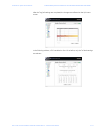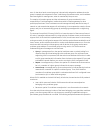
15–4 MULTILINK ML1600 ETHERNET COMMUNICATIONS SWITCH – INSTRUCTION MANUAL
OVERVIEW CHAPTER 15: IGMP
Either of these switches can operate as querier because a multicast router is not present
on the network. (If an IGMP switch does not detect a querier, it automatically assumes this
role, assuming the querier feature is enabled-the default-within IGMP.)
FIGURE 15–2: Isolating multicast traffic in a network
In the above figure, the multicast group traffic does not go to switch 1 and beyond. This is
because either the port on switch 3 that connects to switch 1 has been configured as
blocked or there are no hosts connected to switch 1 or switch 2 that belong to the
multicast group.
For PC 1 to become a member of the same multicast group without flooding IP multicast
traffic on all ports of switches 1 and 2, IGMP must be configured on both switches 1 and 2,
and the port on switch 3 that connects to switch 1 must be unblocked.
15.1.3 IP Multicast Filters
IP multicast addresses occur in the range from 224.0.0.0 through 239.255.255.255 (which
corresponds to the Ethernet multicast address range of 01005e-000000 through 01005e-
7fffff in hexadecimal.) Devices such as the MultiLink family of switches having static
Traffic/Security filters configured with a “Multicast” filter type and a “Multicast Address” in
this range will continue in effect unless IGMP learns of a multicast group destination in this
range. In that case, IGMP takes over the filtering function for the multicast destination
address(es) for as long as the IGMP group is active. If the IGMP group subsequently
deactivates, the static filter resumes control over traffic to the multicast address formerly
controlled by IGMP.
754728A1.CDR


















